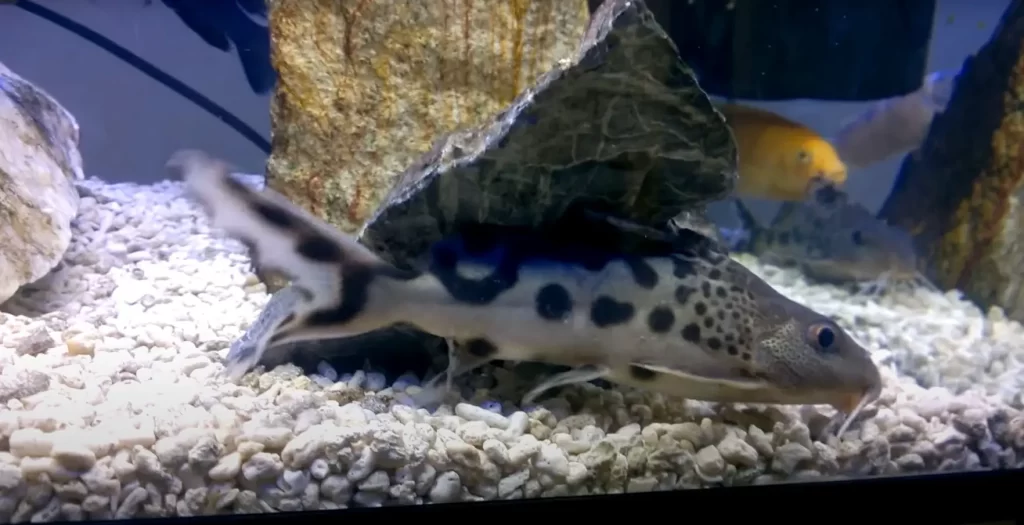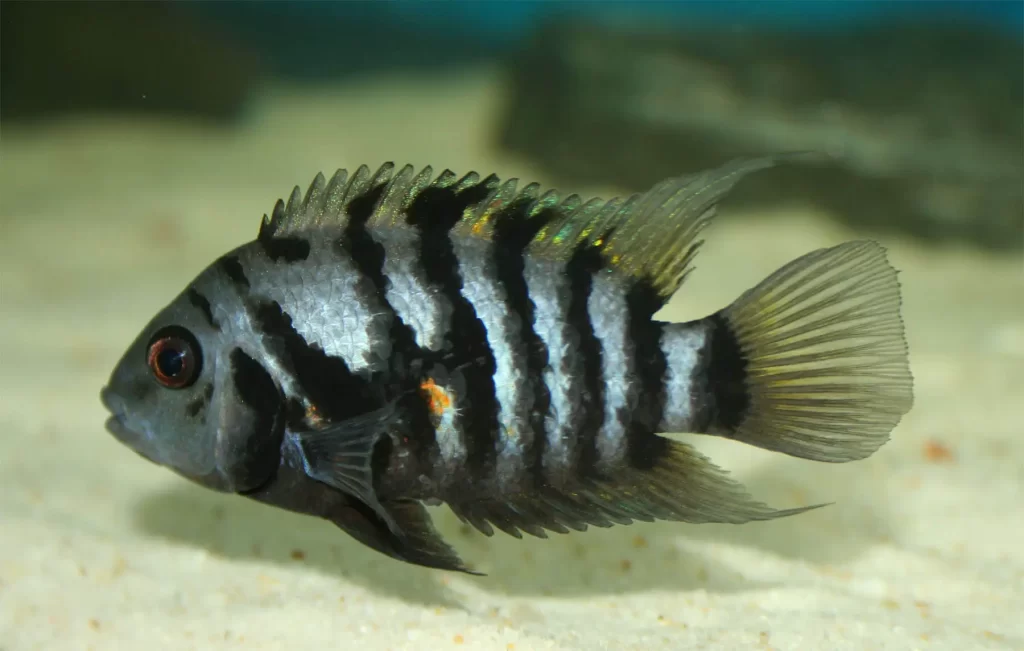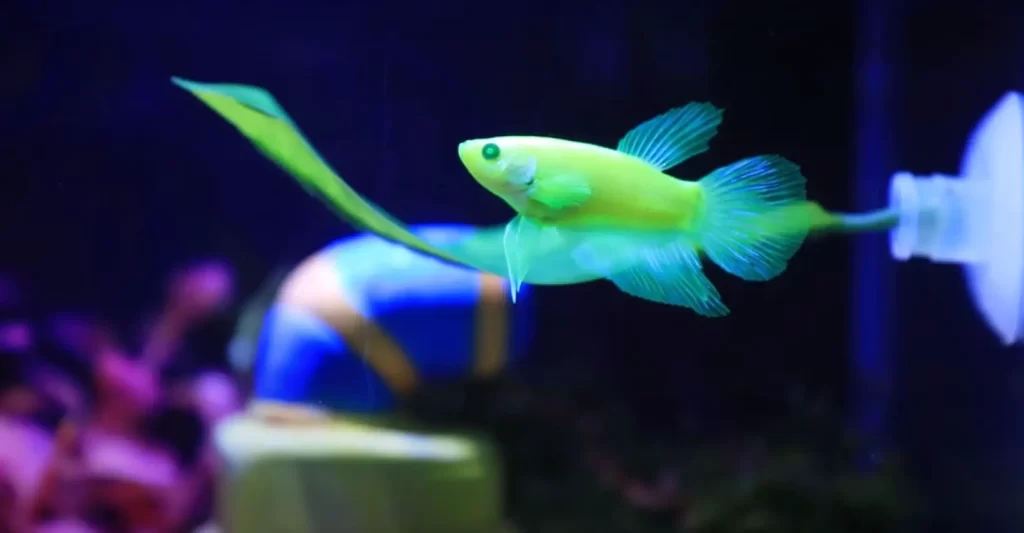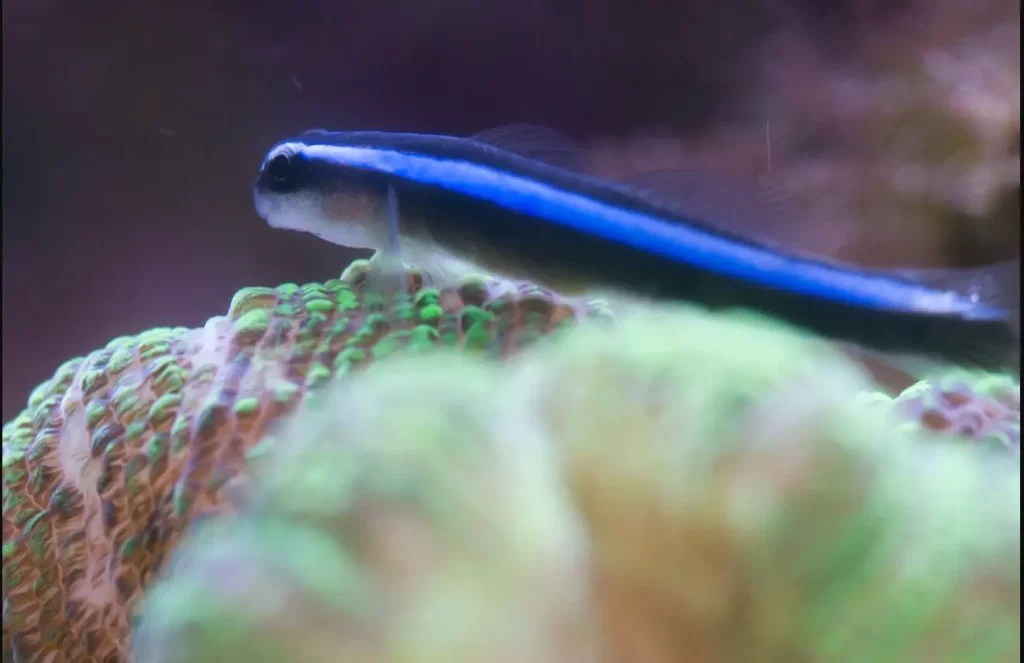Catfish is a large family of freshwater fish. Today people keep various kinds of catfish varying in sizes and colors. One such popular catfish is the Synodontis Decorus Catfish of the Mochokidae family. Because of the hardy nature, this catfish has become quite popular among keepers over the years. Swimming upside down and making squeaky noise when under any threat are some distinct characteristics of this fish.
In this article, we will be looking at the basic care guide of the Synodontis Decorus catfish. I have included things like diet, water parameters, tankmates, and many more. This care guide has enough information for any beginner to start keeping this catfish.
Introduction To Synodontis Decorus Catfish
Synodontis Decorus, also commonly known as clown catfish, clown Synodontis, clown Syno, clown squeaker, or barred-tail squeaker, are popular tropical freshwater fish. The catfishes of this family, Mochokidae are called collectively called squeakers (because of the sound they make) or upside-down catfish.
When people refer to the Synodontis Decorus, they’re referring to the genus of these catfish. This genus consists of a bunch of fish, and all of them have similar body formation.
Because these catfish share their natural habitat with African cichlids, they can tolerate aggression. This is also the main reason for its popularity.
These species of catfish also don’t have any scales on them. So, they are also called naked catfish.
Origin And Habit In The Wild
The fish originates from the Congo Basin in Africa. It is native to countries like Cameroon and Congo. Interestingly it cannot be found in the Luapula River, which is also a major part of the basin.
Its natural habitat consists of slow-moving areas of rivers and flooded zones. Dominant and aggressive fish majorly occupy Their natural home-like cichlids. As a result, these fish have adapted to being opportunistic eaters rather than picky.
Fish Appearance
The long dorsal fin, which can sometimes reach the caudal fin, is a unique feature of this fish. This intriguing property, along with the remarkable coloration, makes this catfish the most popular one in the genus. The fish can grow up to 13 inches in total length.
The fish has three pairs of barbels or whiskers. The body is mostly white, with random large black spots. On the other hand, the head area has small spots that look like holes. Like most of the fish, the ventral region is colorless i.e., white. The Dorsal, caudal, anal, and ventral fins are white with black stripes on them.
Male vs. Female
The adult male is slightly darker than the female. A male might sometimes have black spots on brown or clay color rather than white.
Another way to differentiate the sexes is by looking at the genital papilla. This is a nipple-like structure located below the anal fin. It may be hard to locate this part on a moving fish. So, you should hold the fish in your hand for this. A female has a rounded papilla, whereas the male has a pointed and ridged one. While holding the fish, you must be careful with the long dorsal fin.
Availability
IUCN has classified this species under least concerned (LC), which means that they are available abundantly in the wild and captivity. You are allowed freely to extract them from the wild with only regional permissions. There is also no restriction in keeping and breeding them in captivity.
Lifespan
The average lifespan of Synodontis Decorus is about 5-8 years. This is a long period, and you must maintain the tank properly to achieve this longevity. However, in the wild, they can live up to 25 years and sometimes even more.
Price
Despite its abundance, the fish costs a fortune of about $15. This is mainly due to its presence in the only African continent. In other regions, you may not find this fish naturally. So, mainly because of the shipping costs, the fish’s actual price becomes $15.
General Behavior And Tankmates
Because these fish share their natural habitat with cichlids, they can tolerate aggressive behavior. You can classify these fish as semi-aggressive. They pose very little threat to fish at the middle and top levels. But they can threaten bottom dwellers like Corydoras.
Also, these fish are fast eaters and will quickly eat all the food that you drop in the tank. So, you must make sure that their tankmates are getting enough food.
Synodontis decorus can be a great addition in a cichlid tank. Usually, these fish won’t attack fish with a similar temperament. But they can harass smaller and calmer fishes. If you are planning to keep them with other Synodontis, then the tank should have enough hiding space and large volume. The intra-species bullying might not be life-threatening but can result in stress and illness.
Synodontis decorus poses a great threat to shrimps, snails like ramshorn snail, crabs, and will possibly eat them.
Fish Keeping Difficulty
Probably the only difficulty in keeping these fish is the tank size. You need an extremely large tank, even for one fish, and this can be a serious issue for many fish-keepers. Despite being hardy and easy to take care of, if the size of the tank doesn’t suit them, these fish can die. If you have a perfect size tank, then even some mistakes won’t affect the fish.
Caring For The Clow Catfish (Synodontis Decorus Catfish)
Like any other fish in captivity, these fish also need your attention and constant care. You should try your best to resemble their natural habitat at home. So below is a basic care guide of the Synodontis decorus.
Fish Tank
The minimum tank size for a fully grown Synodontis decorus is about 50 gallons. It is better to have a shallow tank rather than a tall one because these fish spend most of their time at the bottom. Even in such a large tank, these fish can live alone without feeling lonely or left out.
Lightings
The fish prefers darkness rather than light. This is because, in the wild, they are found in the deepest parts of lakes. You can also add floating plants to reduce the intensity of lights. If you have a tank with intense lights and hiding spots, then these fish will hide and only come out for food and wait for darkness.
In a species-only tank, I would not recommend any lights at all.
Decoration And Substate
You should set up a Synodontis decorus catfish’s tank like a theme park. The tank should have caves, tunnels, and driftwoods in such a way that the fish enjoys swimming around, and the swimming space is not obstructed. You can cut sections od pipe that is wide enough for this fish, or you can buy commercially available tunnels. These decorations must create dark areas in the tank. The fish chooses its favorite spot among these decorations with low lightings. It will spend most of its life in this spot.
If you want the fish to be active even in a lit aquarium, then you must install floating plants. These plants reduce light intensity and make the environment more comfortable for the fish.
The choice of substrate can be crucial sometimes. Having hard gravels and rocks can harm the barbels in the fish. So, I recommend having sand as the primary substrate in the tank.
Synodontis Decorus Catfish Diet
Synodontis decorus are opportunistic feeders. In the wild, they eat whatever remaining food they can get after the aggressive, dominant cichlids have eaten. These fish are omnivores meaning their diet consist of plants and animals. In the wild, their diet consists of insect larvae, algae, and any other food that they get.
In the aquarium, these fish are easy to feed and will consume almost anything that you throw at them until it fits their mouth. The fish will accept flake food and pellets as a regular diet. Prefer sinking ones because the fish lies to stay at the bottom. You need to provide occasional treats in the form of blood worms, earthworms, and brine shrimps. This will help the fish feel more satisfied and engaged. You should also include leafy vegetables cut into fine pieces, in their diet.
Also Read: Obesity in Aquarium Fish
Maintain Water Quality
Maintaining water quality is probably the most important factor in fish-keeping. Although these fish can survive in extremely dirty water, maintaining the water in captivity is humane and makes the tank more beautiful.
Water Temperature
The perfect water temperature for this fish would be about 71.6-82.4°F. Since this is tropical fish and is found in the hotter parts of central Africa, the warm temperature is no surprise. Too cold temperatures can cause trouble in swimming and can lead the fish to stress. You should use a heater to maintain this temperature in all seasons.
pH And Hardness
A pH of 6.5 to 7.5 is perfect for the fish to thrive in. Although the fish can tolerate higher acidity or lower pH, it might not be good for the tankmates. So, keeping the water as neutral as possible is the best option.
The fish prefers slightly hard water with rich mineral content.1-4 DH water is perfectly fine. Such water resembles its natural habitat and makes the fish feel like home.
Filtration
Even in a big aquarium, a moderately powerful filter is enough for this fish. These fish don’t produce a ton of bio-load and sometimes even finish up the remaining foods from between the gravels. This reduces the undissolved pollution in the tank. But you need a filter for a complete biological and chemical filtration. The filter must produce moderate water flow so that the fish won’t have a hard time swimming around.
In a community tank, you must choose a powerful filter considering all the fish. But in a species, only tank, a power filter, or a hang-on back filter would do the job.
Water Maintenance
Maintaining the water is just as important as filtration, feeding, and parameters. The tank water must be as comfortable as possible for the fish to thrive in. Looking after the water and treating it regularly always reduces the danger of diseases. The basic thumb of rule is to change about 10% of the water every week. This reduces the concentration of dissolved impurities like phosphates, nitrates, ammonia, and other useless chemicals.
You should also get a complete water test kit. Following the instructions on the kit, you should test the water every 2-3 weeks for ammonia, chlorine, and phosphate levels. If these levels are extremely high or low, then you must take the necessary actions and treat the water accordingly.
A thorough cleaning of the filter and filter media is also important every month. While cleaning the media, you should rinse it with the tank water. This ensures that not all bacterial colonies are washed away or killed.
You should always place a fish in a cycled tank. This is the basic rule of fish-keeping, and this is beneficial for every fish in every manner. A cycled tank has enough bacterial colonies to provide proper biological filtration in a tank.
Clown Catfish Diseases
Synodontis decorus catfish are hardy fish and do not get infected quite easily. However, tropical fish diseases can be seen on them sometimes.
Due to high nitrate levels, the fish might get infected barbels. This might cause trouble in navigating and eating. Barbels are quite sensitive organs and are assets to any catfish. So, maintain a nitrate level of below 20ppm is mandatory or this fish.
Feeding a balanced diet, and giving a proper living environment for the fish can help it stay safe from any diseases. A stressed fish is more likely to get ill, so try to make the fish happy and satisfied in the tank. Adding tunnels, caves, reducing lights, and providing occasional treats play a great role in stress reduction.
Breeding The Synodontis Decorus Catfish
There is no evidence showing the successful breeding of these fish in the home aquarium. However, people have bred them in fish farms by adding hormones.
Conclusion
All in all, Synodontis decorus are a great addition to your aquarium and are easy to take care of. You can keep them with cichlids or alone. Attractive coloration, hardy nature, compatible behavior, and calm temperament makes these fish more desirable.
I think all the data that I have provided is more than enough. If you follow the instruction above, you will be able to keep these fish without facing any difficulty. If you have any feedback, then they are heartily welcomed in the comment section below.
Reference
Image Credit
- https://www.youtube.com/watch?v=ki1p9RgkyHo






